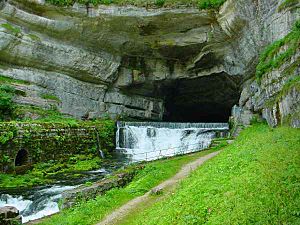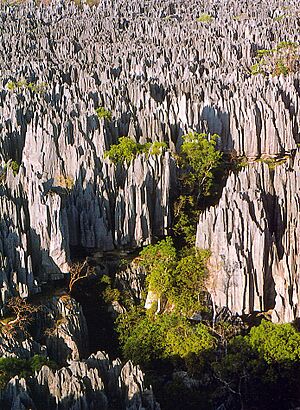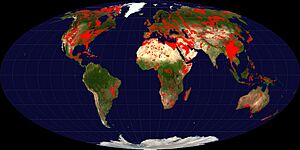Karst facts for kids


Karst is a special type of landscape. It forms when water dissolves soft rocks like limestone or dolomite. These rocks are called carbonate rocks. Over time, water seeps into cracks and slowly eats away at the rock. This creates unique features both above and below the ground.
Karst areas can be found all over the world. This is because carbonate rocks are very common. When karst covers a large area, it becomes a major part of the geography. Sometimes, it can be very hard to travel through these areas. This is because the ground can be rough and uneven.
Many karst places have special features on the surface. The most common of these are sinkholes. But sometimes, you might not see these features. This happens if the soluble rock is covered by another type of rock. Many karst regions also have thousands of caves. The water in these areas usually flows underground.
The biggest karst area in the world is the Nullarbor Plain. It is a flat, dry, and almost treeless area in southern Australia. It is next to the Great Australian Bight coast. To its north is the Great Victoria Desert. This plain is the largest single area of exposed limestone rock on Earth. It covers about 200,000 square kilometres (77,000 sq mi). At its widest, it stretches about 1,100 kilometres (684 mi) from east to west. It crosses the border between South Australia and Western Australia.
What are Sinkholes?
Many places around the world have problems with sinkholes. These holes form when karst systems are hidden underground. Below the flat ground in places like Florida and Guatemala City, there are huge systems of limestone. Water flows through this limestone, slowly dissolving it away. This creates very large underground caves.
Suddenly, without warning, huge holes can appear on the surface. These sinkholes can cause a lot of damage. Almost all of Florida sits on a giant karst system. Several countries in Central America also have them. The area around Tampa is especially at risk. There is also a huge karst system under Mexico City. One expert says there are as many as 15,000 sinkholes in Illinois.
The deepest sinkhole in the world is Xiaozhai Tienkeng in China. It is 2,172 feet (662 meters) deep.
The Qattara Depression in Egypt is part of the Libyan Desert. It is roughly 50 miles (80 km) wide and 75 miles (121 km) long. This is the world's largest natural sinkhole. It lies below sea level. It is covered with salt pans, sand dunes, and salt marshes.
Related Topics

Images for kids
-
Škocjan Caves, Slovenia
-
A doline (a type of sinkhole) in the causse de Sauveterre, Lozère, France.
-
A limestone deposit in the Dinaric Alps near Sinj, Croatia.
-
Rubaksa tufa plug in Ethiopia.
-
Lunan Stone Forest, Yunnan, China.
See also
 In Spanish: Karst para niños
In Spanish: Karst para niños










